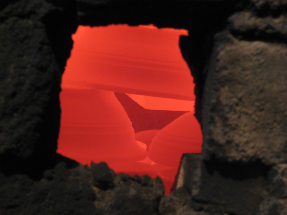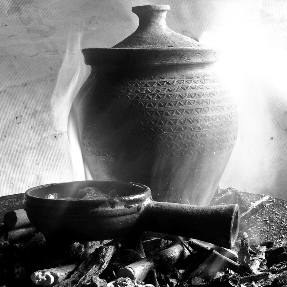
Our pottery is made using various techniques. We hand build, turn and throw
it using numerous tools and wheels from respective historical periods.
On the SLOW WHEEL (also called a tournette) the walls of the vessel are built using the coil method. First we form the bottom, then we press the long, thin piece of clay into it, forming a wall. Adding further strips (or rolls) of clay allows us to build a vessel of desired shape and size. Such vessel is then smoothed out with wooden and bone tools and TURNED on the wheel while the potter applies pressure to it with a wet hand.
The next method we use is THROWING on a FAST WHEEL. Vessels are pulled from a single piece of clay by applying pressure and moisture while spinning. We use this method mostly to make late medieval and modern age pottery.
The middle part of the bottom is set on a primer of sand. It makes removing
a finished vessel from the wheel easier. Not all our pottery is glazed, which
is dictated by historical reality – many vessels from the area of today’s
Poland were not glazed, not only in early Middle Ages but also much later. Lack
of glaze does not mean low quality – our vessels are waterproof and can hold
water for many days. Naturally they absorb moisture to some degree so we advise
to dry them after use, before packing them into the chest awaiting for the next
adventure.
HISTORY
First of the methods presented above is also called wheel-coiling. If the
potter used water to shape and smoothen the vessel on a slow wheel, such
technique is called WHEEL FINISH. Such methods were used by potters from 10th
to 14th century in Poland; they were gradually abandoned since 1450s
with the advent of THROWING vessels from a single lump of clay on a fast wheel.
In earlier times (Bronze Age, Period of Roman Influence) pottery was made
by coiling; smaller vessels were made by hand out of single piece of clay. All
vessels were carefully finished and smoothed with tools (polished piece of bone
or a scrap of leather). It was truly a golden age of pottery – plethora of
designs, shapes and decorations. Middle Ages seem really quaint in comparison.
COOKWARE
In early and late Middle Ages kitchen vessels were rather plain, with
little or no decoration and relatively thick walls. A characteristic S-shaped
profile and modest sizes made them easy to use. They were grasped by the neck,
and the flaring of the lip allowed to pick them up from a fire with metal
forks.
For the vessel to be suitable for cooking (regardless of the historical
period) the clay used to make it must contain proper admixture (granite dust
which makes it more resistant to temperature changes).
FIRING
Firing is done in a wood burning kiln. The kiln has two chambers: the upper one contains previously dried pottery, the bottom one burning wood. In the past ages it was the only way to transform clay vessels into usable, waterproof cookware.
Wood burning kiln, apart from regular (oxidation) firing, makes REDUCTION FIRING possible. In this process in the last phase of the firing the oxygen flow is shut off which starts a chemical reaction on the surface of fired wares, giving them dark or black coloring.This method of firing was used since antiquity. Dark pottery was used throughout Europe in the Bronze Age and in the Period of Roman Influence. It reemerges in early Middle Ages, but flourishes and spreads later. According to historians and archeologists the “new fashion” for dark clayware started in the northern Europe around 12th century. In 13th century it arrived to Poland and became dominant as a most popular firing method for two hundred years. Of course other types of clayware remained in use and the processes of clayware domination and later, gradual return to oxidation firing were not uniform. They depended on many factors and happened differently in particular regions. The technology of reduction firing never vanished, it remained in the ethnography as “siwaki”.






